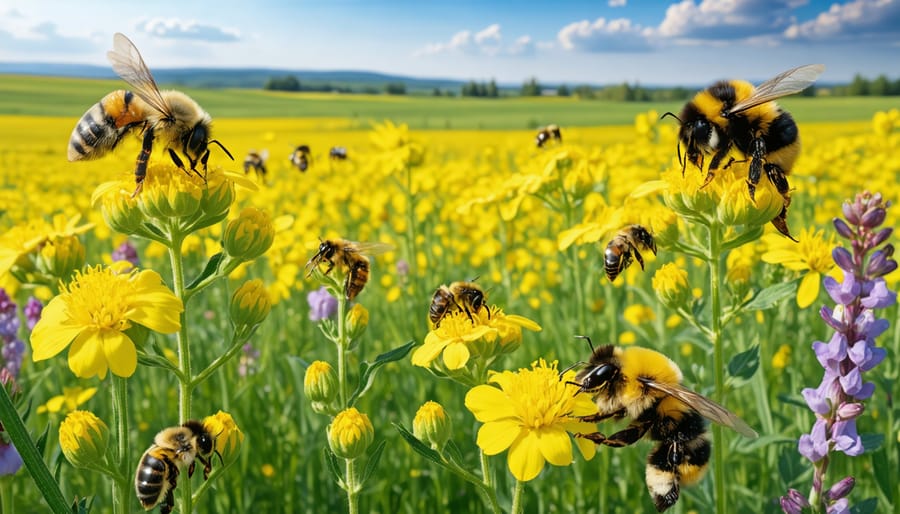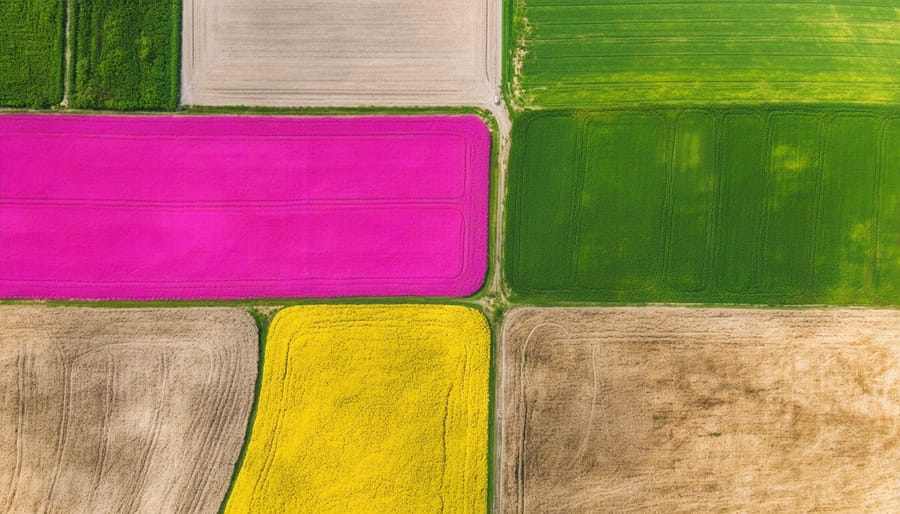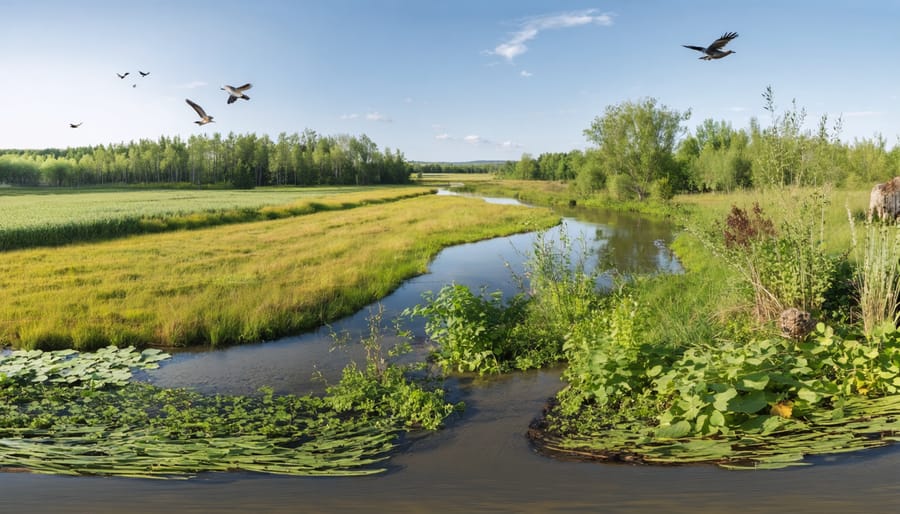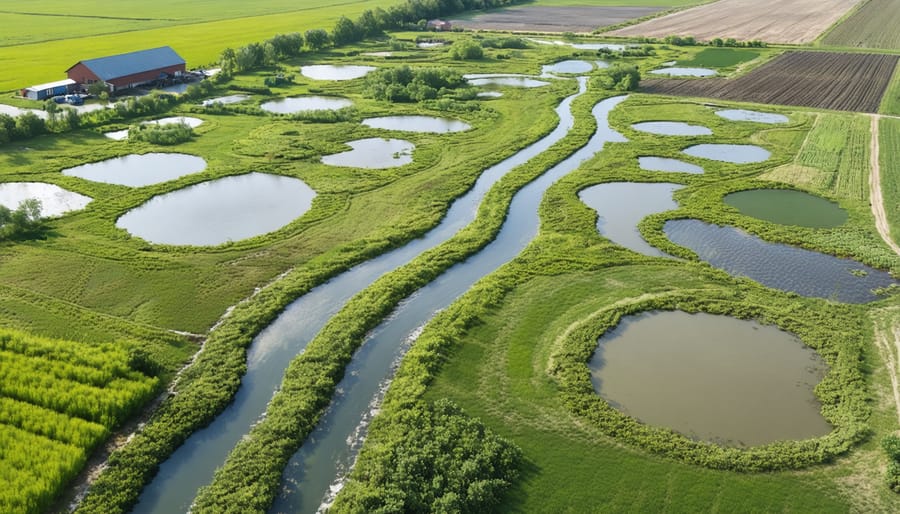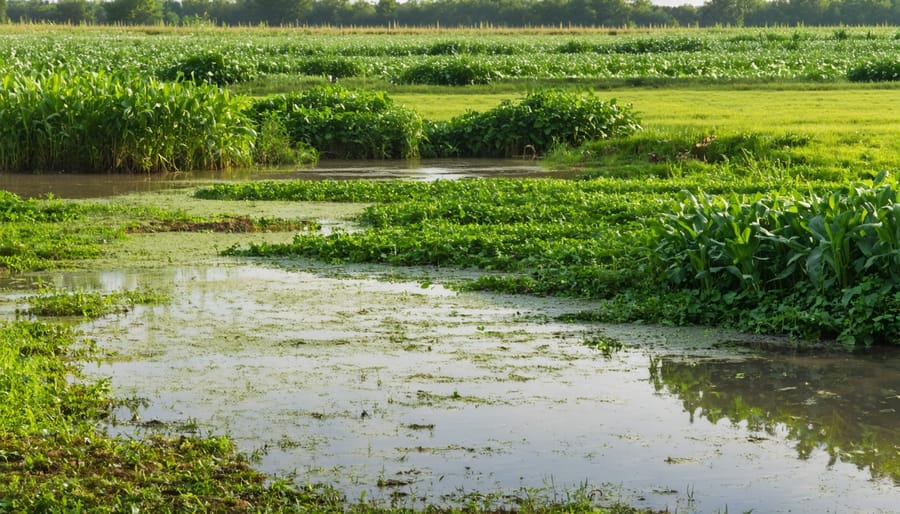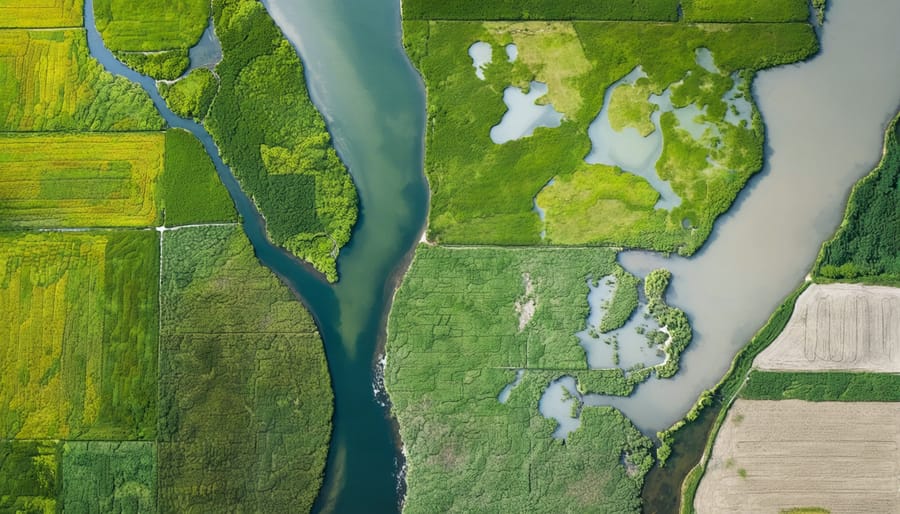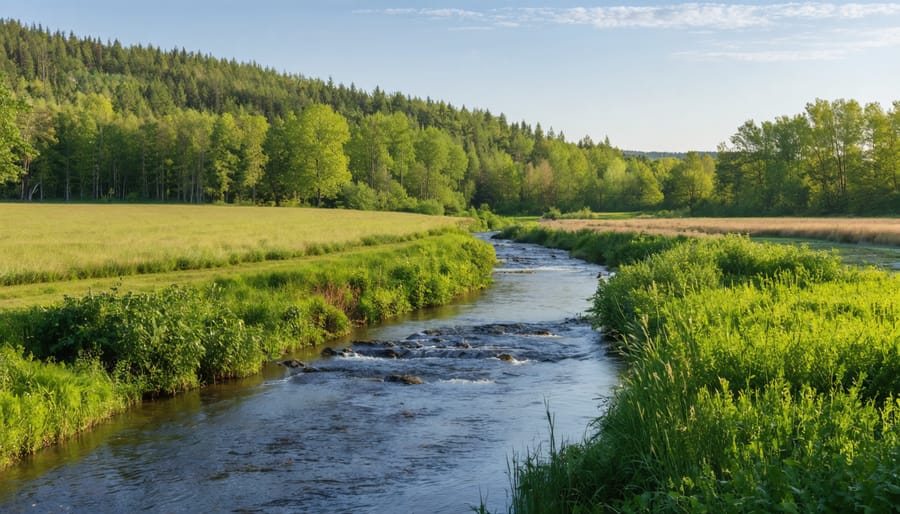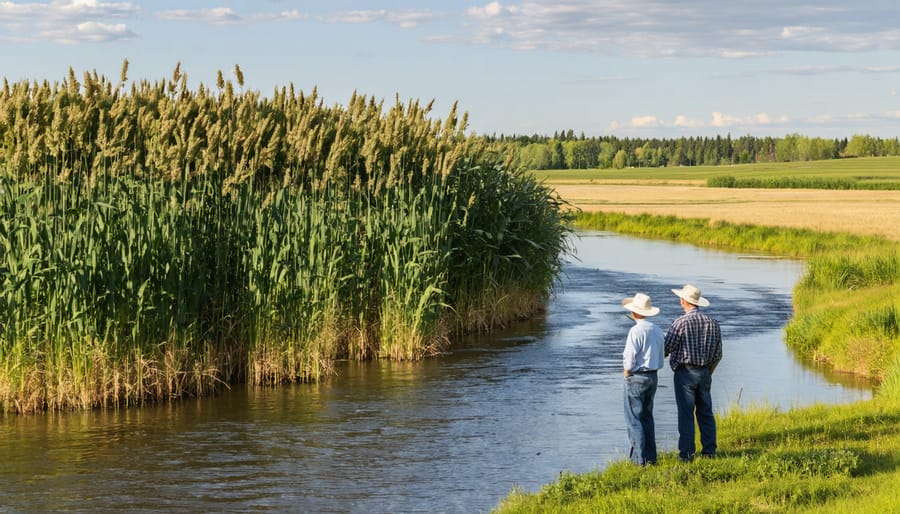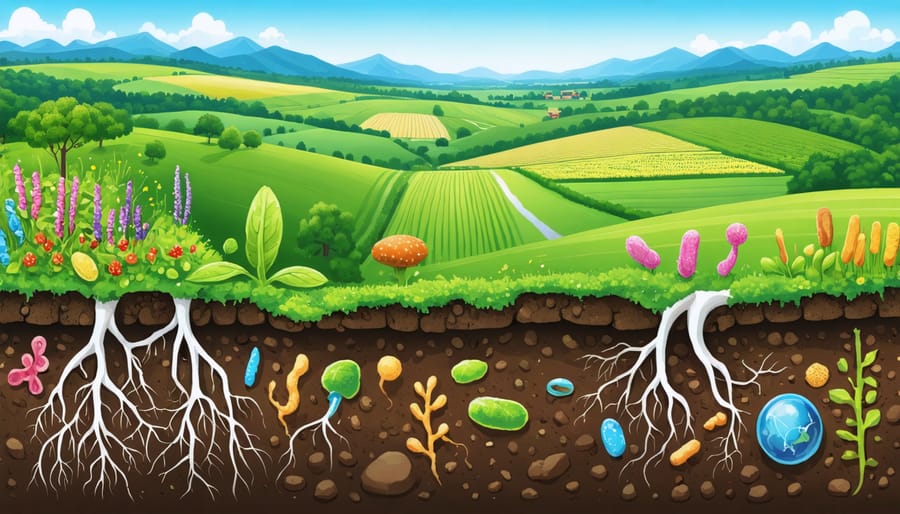Alberta’s farmlands stretch across 50.5 million acres, creating one of North America’s most productive agricultural regions where innovation meets tradition. From the fertile Peace River Valley to the sun-drenched southern prairies, farmers cultivate everything from canola and wheat to pulse crops and specialty organic produce. The critical role of bees and other pollinators has helped transform these landscapes into a powerhouse that generates over $12.5 billion annually in agricultural exports.
Modern Alberta farming embraces cutting-edge technology while maintaining sustainable practices that have evolved over generations. Smart irrigation systems now work alongside century-old crop rotation techniques, while precision agriculture helps farmers maximize yields while minimizing environmental impact. This unique blend of old and new has positioned Alberta as a global leader in agricultural innovation, with over 40,000 farms adapting to changing climate patterns and market demands.
The province’s diverse agricultural sector supports not just local food security but feeds millions worldwide, demonstrating how careful stewardship of the land can create both economic prosperity and environmental sustainability. As climate challenges mount, Alberta’s farming community continues to pioneer solutions that could shape the future of agriculture worldwide.
Alberta’s Native Pollinators: The Hidden Heroes of Organic Farming
Beyond Honeybees: Alberta’s Wild Pollinators
While honeybees often steal the spotlight, Alberta’s agricultural success relies heavily on native pollinators that have evolved alongside our local ecosystems. The province is home to over 300 species of wild bees, including the industrious bumble bees, efficient leaf-cutter bees, and tiny mason bees that emerge early in spring to pollinate fruit trees.
These indigenous pollinators offer distinct advantages over their honey-producing cousins. Bumble bees, for instance, can forage in cooler temperatures and lower light conditions, extending the daily pollination window. They’re also expert “buzz pollinators,” using vibration to release pollen from certain crops like tomatoes and peppers.
Butterflies, particularly the Painted Lady and Red Admiral species, contribute significantly to Alberta’s pollination network. Moths, often overlooked, play a crucial role in night pollination of evening-blooming plants. Even flies, especially hover flies, serve as important backup pollinators during adverse weather conditions.
To support these vital creatures, many Alberta farmers are creating pollinator-friendly habitats by maintaining natural areas, planting native flowering species, and reducing pesticide use. Simple actions like leaving unmowed strips along field edges and preserving dead wood for nesting sites can significantly boost pollinator populations and, consequently, crop yields.
Understanding and protecting our diverse pollinator community isn’t just good ecology – it’s smart farming that helps ensure resilient and productive agricultural systems for future generations.
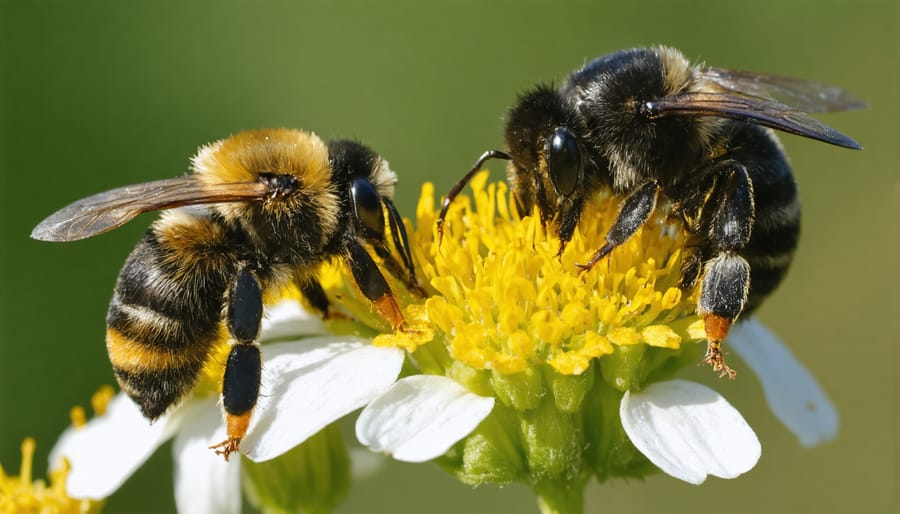
Crop-Specific Pollination Needs
Alberta’s diverse crop varieties each have unique pollination requirements, and understanding these needs is crucial for optimal yields. Canola, one of Alberta’s primary crops, benefits significantly from honey bees and native leaf-cutter bees, which can increase yields by 10-30%. These pollinators are particularly effective during the brief flowering period when temperatures reach above 12°C.
For pulse crops like field peas and fava beans, bumble bees prove especially valuable due to their ability to work in cooler conditions and their “buzz pollination” technique. Local studies have shown that wild bumble bee populations can improve field pea yields by up to 15% compared to fields without these natural pollinators.
Berry crops, including saskatoons and haskap, rely heavily on both mason bees and bumble bees. These native pollinators are active earlier in the spring than honey bees, making them crucial for early-blooming fruit crops. Vegetable seed production, particularly for carrots and onions, benefits from diverse pollinator populations, with hover flies and small native bees playing essential roles.
Alfalfa seed producers often work with leaf-cutter bees, which are particularly efficient at tripping the flower’s unique pollination mechanism. These specialized bees can increase seed production by up to 70% when properly managed. Local farmers have found success by maintaining nesting sites and ensuring diverse flowering plants are available throughout the growing season to support these valuable pollinators.
Creating Pollinator-Friendly Organic Farms
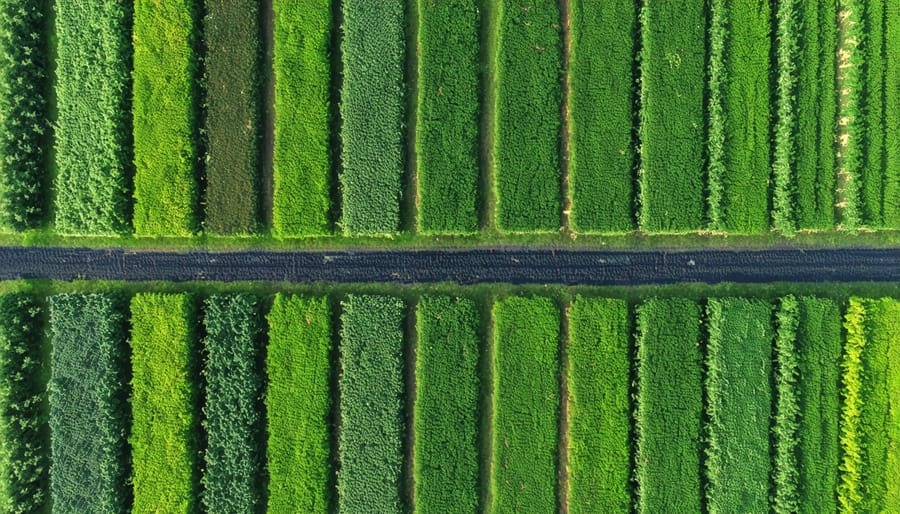
Habitat Design and Management
Creating pollinator-friendly habitats in Alberta farms requires thoughtful design and consistent management practices. To effectively boost farm biodiversity, farmers should focus on establishing diverse native plant communities that bloom throughout the growing season.
Start by identifying existing natural areas on your farm that can serve as pollinator corridors. Plant native wildflowers like wild bergamot, blanketflower, and golden rod in field margins and unused areas. These species are well-adapted to Alberta’s climate and provide essential nectar and pollen resources.
Consider establishing hedgerows using flowering shrubs such as saskatoon berry, chokecherry, and wild rose. These create windbreaks while offering nesting sites and food sources for native bees and other beneficial insects. Leave some bare ground patches and old plant stems for ground-nesting bees.
Maintenance is crucial for long-term success. Implement rotational mowing schedules that allow portions of habitat to remain undisturbed throughout the season. Avoid pesticide use near pollinator areas and maintain buffer zones between treated crops and pollinator habitats.
Water sources are essential – shallow dishes with stones or small ponds can provide safe drinking spots for pollinators. During Alberta’s dry periods, these features become particularly important for supporting pollinator populations.
For best results, coordinate with neighboring farms to create connected habitat corridors that support pollinator movement across the landscape.
Seasonal Planting Strategies
In Alberta’s unique climate, planning for year-round pollinator support requires strategic planting schedules that align with our distinct growing seasons. By creating wildlife-friendly habitats, farmers can ensure continuous forage availability from early spring through late fall.
Start with early-blooming crops like saskatoon berries and wild roses in April and May, which provide crucial nutrition for emerging native bees. Follow with summer-flowering canola, alfalfa, and clovers from June through August, offering abundant nectar sources during peak pollinator activity. Late-season plants like asters and goldenrod extend forage into September and October.
Consider implementing succession planting techniques, where crops are planted at staggered intervals to extend blooming periods. This approach is particularly effective with vegetables like cucumber and squash, which require pollination for fruit development.
Include native perennials in field margins and buffer zones to support local pollinator species. Plants like bergamot, blanketflower, and prairie coneflower are well-adapted to Alberta’s climate and provide reliable forage sources. Maintain some areas of bare soil for ground-nesting bees, and leave standing plant material over winter to protect pollinator habitat.
Remember to account for Alberta’s unpredictable weather patterns by incorporating drought-resistant species and maintaining windbreaks to create sheltered areas for pollinators during adverse conditions. This comprehensive approach ensures a resilient pollinator-supporting ecosystem throughout the growing season.
Organic Pest Management That Protects Pollinators
Alberta farmers are increasingly adopting organic pest management strategies that protect essential pollinators while effectively controlling harmful pests. A key approach is the use of companion planting, where crops like dill, yarrow, and native wildflowers are strategically placed to attract beneficial insects that naturally control pest populations.
Timing is crucial for pest management in Alberta’s climate. Many farmers conduct pest control activities early in the morning or late in the evening when pollinators are less active. This practice significantly reduces the risk to bees and other beneficial insects while maintaining effective pest control.
Physical barriers like row covers and insect netting have proven successful in protecting crops without the use of chemicals. These barriers are particularly effective during critical growth stages and can be removed during flowering to allow pollinator access. Many Alberta farmers also maintain buffer zones of native vegetation around their fields, creating natural habitats for beneficial insects while serving as barriers against pest migration.
Biological controls, such as introducing predatory insects like ladybugs and parasitic wasps, have shown excellent results in controlling aphids and other common pests. Local success stories include organic market gardens near Edmonton that have reduced pest damage by 60% through integrated pest management strategies.
Regular monitoring and early detection remain fundamental to successful organic pest control. Many farmers participate in provincial monitoring networks to track pest populations and share effective management strategies within the farming community.
Success Stories: Alberta Organic Farmers Leading the Way
Red Deer Valley Organics: A Pollinator Paradise
Nestled in the heart of central Alberta, Red Deer Valley Organics has transformed 160 hectares into a thriving ecosystem where agriculture and biodiversity flourish together. Farm owners Sarah and Michael Thompson started their pollinator program in 2015, recognizing the vital role of beneficial insects in organic farming success.
“We noticed a significant decline in native pollinators over the years,” explains Sarah. “That’s when we decided to take action and create a farm that works with nature rather than against it.” Their comprehensive approach includes maintaining 15% of their land as natural habitat, featuring carefully designed pollinator corridors that connect different parts of the farm.
The Thompsons’ pollinator strategy incorporates diverse flowering plants blooming from early spring through late fall. Native species like golden rod, wild bergamot, and purple coneflower provide essential nutrition for local bee populations. They’ve also installed over 200 bee hotels throughout the property, offering nesting sites for solitary bees.
The results speak for themselves. Since implementing their pollinator program, Red Deer Valley Organics has seen a 40% increase in crop yields, particularly in their fruit and vegetable operations. They’ve documented 76 different pollinator species on their land, including the endangered western bumble bee.
The farm also serves as an educational hub, hosting workshops for local farmers interested in implementing similar practices. “It’s not just about our farm,” Michael notes. “We’re creating a blueprint that other Alberta farmers can adapt to their operations.”
Their success has attracted attention from agricultural researchers and conservation groups across Canada. The farm’s practices have been recognized by the Alberta Organic Producers Association for excellence in sustainable agriculture, demonstrating that pollinator conservation and profitable farming can go hand in hand.
Measuring Success: Yield Improvements and Biodiversity Gains
Recent data from Alberta’s agricultural sector shows promising results for farms implementing pollinator-friendly practices. A 2022 study conducted by the University of Alberta documented an average yield increase of 23% in canola fields where native pollinator habitat was maintained, compared to conventional fields without dedicated pollinator spaces.
Several case studies highlight these improvements. The Morrison Family Farm in Red Deer County reported a 27% increase in alfalfa seed production after establishing wildflower corridors and reducing pesticide use. Similarly, the Watershed Apiaries project in Lacombe demonstrated that farms maintaining natural hedgerows saw berry yields improve by up to 35% while supporting diverse native bee populations.
Biodiversity monitoring across participating farms has revealed encouraging trends. The Alberta Biodiversity Monitoring Institute recorded a 40% increase in native bee species on farms implementing pollinator programs over a five-year period. Particularly notable was the return of previously declining species like the western bumble bee and the rusty-patched bumble bee to restored habitats.
Economic benefits have been substantial. Farmers participating in pollinator conservation programs reported average cost savings of $45 per hectare through reduced pesticide use and natural pest control services provided by beneficial insects. Additionally, many farmers have found new revenue streams through agritourism and educational programs centered around their pollinator initiatives.
The success metrics extend beyond traditional crop yields. Water retention improved by 30% in areas with established pollinator habitat, while soil erosion decreased significantly. These environmental gains contribute to long-term farm sustainability and resilience against climate challenges.
Monitoring efforts continue through collaborative projects between farmers, researchers, and agricultural extension services, providing valuable data to refine and improve pollinator conservation strategies across Alberta’s diverse agricultural landscapes.
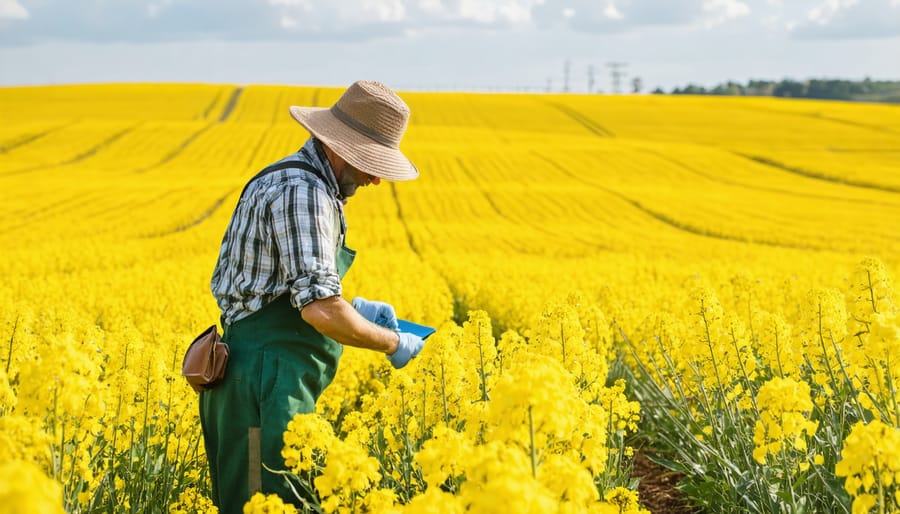
The journey toward pollinator-friendly organic farming in Alberta represents a win-win opportunity for both agricultural producers and our vital insect partners. By implementing the strategies outlined in this guide, farmers can create thriving ecosystems that support both crop production and pollinator populations. The evidence from local farms shows that investing in pollinator habitat not only increases yield potential but also enhances soil health and biodiversity across the landscape.
As we look to the future of sustainable agriculture in Alberta, the next steps are clear. Start by conducting a baseline assessment of your farm’s current pollinator populations and existing habitat. Consider joining local farmer networks and participating in citizen science projects to share knowledge and contribute to our understanding of pollinator patterns in the region. Take advantage of available resources through Alberta’s agricultural extension services and organic farming associations to develop a customized pollinator conservation plan.
Remember that every step, no matter how small, contributes to the larger goal of creating resilient agricultural systems. Whether it’s planting a hedgerow, adjusting mowing schedules, or establishing flowering cover crops, these actions build upon each other to create meaningful change. By working together as a farming community, we can ensure that Alberta’s agricultural lands continue to buzz with life while producing the food that sustains our communities.
The time to act is now. Our pollinators need our support, and in return, they’ll help secure the future of organic farming in Alberta for generations to come.

